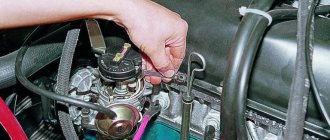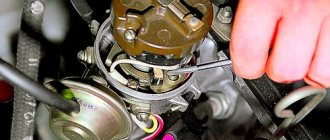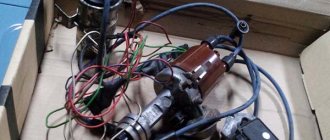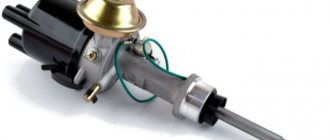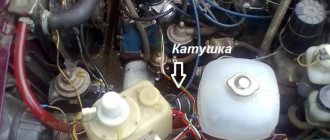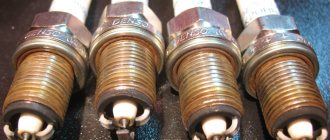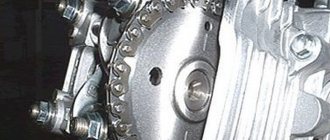Home » Domestic auto industry
Reading time: 6 minutes. Updated 08/04/2019
The efficiency of the engine and its successful starting, as well as the dynamics of the car when driving and fuel consumption depend on whether the ignition adjustment is carried out correctly. The article provides instructions and recommendations on how to correctly set the electronic ignition on a VAZ 2106 car, as well as a training video on adjusting the ignition.
Detailed guide to setting up the ignition
Motorists have long been convinced of the advantages of electronic (non-contact) ignition, which does not have the disadvantages of contact ignition, for example, there is no need to adjust the gap in the contact group. In this article we will look at how to adjust the ignition on a VAZ 2106 for the 1st cylinder.
There are marks and castings on the cylinder head cover and crankshaft pulley.
Using the marks you can adjust the ignition timing:
- the first mark, located clockwise, means that the ignition timing is 10°;
- the middle mark is designed to set the lead angle to 5°;
- the shortest, last mark sets the advance angle to 0°: in this case, the mixture will ignite when the piston reaches top dead center.
Marks on the cylinder head cover
The marks are aligned by rotating the crankshaft, either using a ratchet, or using a special wrench on the nut.
Tools and materials
In order to adjust the ignition on a VAZ 2106, you need to prepare the following tools:
- key for unscrewing spark plugs;
- special key for rotating the crankshaft;
- key to "13";
- control device: 12 V indicator light or voltmeter.
You can also expose using a stroboscope.
Stages
The ignition is set step by step:
- We disconnect the car from the power supply by removing the negative terminal from the battery.
- Using a spark plug wrench, unscrew the spark plug of the 1st cylinder. After this, close the hole from the candle with your finger or rubber stopper.
Close the hole with your finger
- Next, using a special key, we turn the crankshaft from left to right until the piston in the 1st cylinder begins its upward movement, that is, the compression stroke begins. At this moment, either the plug will pop out, or the finger closing the hole will feel the air being squeezed out with great force.
- The crankshaft must be turned until the marks on its pulley and the timing cover align. If you fill your car with 92 or 95 gasoline, then the mark on the pulley must be aligned with the middle notch; if 76 and below, then with a length indicating zero ignition timing.
- After unclipping the latches, remove the distributor cap.
- When the crankshaft will no longer turn, the distributor should be turned to the first cylinder with its outer contact.
- After aligning the marks, if everything is done correctly, the line mentally connecting the distributor latches should be parallel to the axis of the power unit. Otherwise, you should slightly unscrew the distributor mounting nut and turn the distributor upward. By rotating the rotor axis, it is necessary to place it parallel to the axis of the power unit.
- Next you need to set the ignition timing. To carry out this procedure, you need to connect the power and connect the negative terminal to the battery.
- Then, using a “13” wrench, loosen the nut that holds the ignition distributor.
- Next, we will use an indicator light, from which there are two wires. One of them should be connected to the ground terminal, the second to the low-voltage output of the coil.
- Turn the key to position “I” and turn on the ignition. Then, slowly, turn the distributor from left to right until the “control” goes out. If the light does not light up immediately, then no action needs to be taken.
- Next, turn the distributor to the left. At the moment when the light comes on, you need to tighten the fastening nut to fix the position in which the distributor is located.
- Now you can turn off the engine and return the distributor cap to its place (video author Nail Poroshin).
External contact position
Types of systems
For decades, while the VAZ 2107 model was produced (from 1982 to 2012), it was equipped with three types of ignition systems:
- mechanical with contacts - breakers;
- contactless;
- controlled by an electronic unit (ECU).
Contact ignition circuit installed in the first VAZ 2107 models
Note. The first 2 varieties were installed on the “seven” with a carburetor, the latter was introduced together with an injector.
In the mechanical version, the contacts opened by the cam of the distributor shaft break the low voltage circuit, initiating the formation of a powerful pulse in the secondary winding of the coil. This discharge is directed to the electrodes of the spark plug, which ignites the fuel in the cylinder where the piston has risen to top dead center (TDC) and the compression stroke is completed.
Scheme of non-contact ignition of the seven with a carburetor
The contactless circuit operates on the same principle, only the signal to break the circuit is supplied by the Hall sensor, and it is implemented by the switch. Therefore, setting the ignition on carburetor “sevens” is done almost identically. Another thing is cars with an injector, where a new system has been introduced that does not have not only contacts, but also a distributor and any moving parts. Here, the moment of spark formation is determined by the ECU controller, which is guided by the signals of various sensors.
Ignition system VAZ 2107 with injector
Recommendations
There are main symptoms by which one can judge that it is necessary to set the ignition on the VAZ 2106:
- Fuel consumption is too high. With late ignition, the dynamics of the car decreases. In order for the car to accelerate as before, it needs more fuel-air mixture.
- Dynamics is lost: with late ignition, the mixture ignites after the piston has already moved down due to the inertia of the flywheel.
- Popping sounds in the muffler. In this case, the explosion follows, and it takes some time for the gases to expand. When the piston reaches bottom dead center, the next stroke will be the exhaust stroke. In this case, part of the fuel explosion will escape into the exhaust pipe, which is the cause of the popping noise.
- Increased engine noise. If the engine noticeably rattles or detonates, you need to turn on the ignition. In this case, the piston only goes up, and the ignition goes towards it. This makes the engine run rough with unpleasant sounds when running.
CONTACTLESS TRAMBER VAZ 2107
Contactless and electronic ignition are the same thing. However, some argue that the systems are different. The fact is that different devices are used in the ignition systems of carburetor and injection engines. Perhaps this is where the confusion arises. True to its name, a contactless distributor does not have mechanical contacts, the functions of which are performed by a special device - a switch.
The main difference between a contactless ignition system and a contact one is the absence of contacts in the distributor and the presence of a special switch
The main advantages of a contactless distributor over a contact distributor are as follows:
- there is no need for periodic maintenance of contacts;
- due to the absence of a contact group that is subject to wear, reliability increases;
- the spark is distributed more evenly among the cylinders and does not depend on the engine operating mode;
- due to the absence of vibration and mechanical impacts on the contacts, the service life of the distributor increases;
- fuel consumption decreases, engine power increases, the content of harmful substances in the exhaust decreases;
- The engine starts more easily at low temperatures, since the voltage at the spark plugs remains stable at low speeds and a weakly charged battery.
CHECKING THE CONTACTLESS DISPENSER
If problems arise in the contactless ignition system, first check the spark plugs for the presence of a spark, then the GDP and the coil. After this they move on to the distributor. The main element of a contactless distributor that can fail is the Hall sensor. If a sensor is suspected of being faulty, it is either immediately replaced with a new one or checked with a multimeter set to voltmeter mode.
The main element that can fail in a contactless distributor is the Hall sensor
Diagnostics of the performance of the Hall sensor is carried out as follows:
- Pins are used to pierce the insulation of the black-white and green wires going to the sensor. A multimeter set in voltmeter mode is connected to the pins.
- Turn on the ignition and, slowly rotating the crankshaft, look at the voltmeter readings.
- If the sensor is working properly, the device should show from 0.4 V to the maximum value of the on-board network. If the voltage is lower, the sensor is faulty and needs to be replaced.
VIDEO: CHECKING THE HALL SENSOR
In addition to the Hall sensor, a malfunction of the vacuum corrector can lead to distributor failure. The functionality of this node is checked as follows.
- Remove the silicone tube from the carburetor and start the engine.
- We create a vacuum by taking the silicone tube into the mouth and sucking in air.
- We listen to the engine. If the speed increases, the vacuum corrector is working. Otherwise, it is replaced with a new one.
The cause of distributor failure may be a breakdown of the vacuum corrector
It may also be necessary to diagnose the centrifugal ignition timing regulator. This will require disassembling the distributor. Particular attention should be paid to the condition of the springs - you need to evaluate how the regulator weights diverge and converge.
When checking a non-contact distributor, it is necessary to assess the condition of the springs of the centrifugal regulator
In addition, it is necessary to check the distributor cover. To do this, it is removed and inspected for burnout, cracks, and the condition of the contacts is assessed. If there is visible damage or signs of wear on the contacts, a new cover is installed. Then the runner is inspected. If traces of severe oxidation or destruction are detected, it is replaced with a new one. And finally, use a multimeter set to ohmmeter mode to check the resistance of the resistor, which should be 1 kOhm.
VIDEO: CHECKING THE COVER OF THE VAZ 2107 TRUMBLER
Video “Design and configuration of the electronic ignition system on the VAZ 2106”
In this video, Albert Sroslov talks about contactless (electronic) ignition and demonstrates how to set the ignition on a VAZ 2106.
The condition for quick engine starting and uninterrupted operation is that the ignition is set correctly. Due to its incorrect installation, detonation may occur, and its result will be serious consequences and engine breakdown. Experienced drivers set the ignition by eye, others use a strobe light, and beginners usually turn to a car service center. However, if the result is good, the move itself does not matter.
HIGH VOLTAGE WIRES
High voltage wires (HVW) transmit impulses from the coil to the spark plugs. Unlike other wires, they must not only withstand high voltage, but also protect other parts of the car from it. Each wire consists of a conductor with a metal tip, rubber caps on both sides and insulation. The serviceability and reliability of the insulation is of great importance, since it:
- prevents moisture from entering the conductive element;
- reduces current leakage to a minimum.
FAULTS IN HIGH VOLTAGE WIRES
The following main malfunctions are characteristic of GDP:
- breakage of the conductive element;
- voltage leakage due to poor insulation;
- excessively high wire resistance;
- unreliable contact between the GDP and the spark plugs or its absence.
If the VV is damaged, the electrical contact is lost and a discharge occurs, leading to voltage loss. In this case, the spark plug receives not the rated voltage, but an electromagnetic pulse. Faulty wires lead to improper functioning of some sensors and interruptions in the operation of the power unit. As a result, one of the cylinders stops performing useful work and runs idle. The power unit loses power and begins to detonate. In this case, they say that the engine is “troubling.”
One of the malfunctions of high-voltage wires is a break
DIAGNOSTICS OF HIGH VOLTAGE WIRES
If you suspect a malfunction of the engine (the engine is “troubling”), they must first be carefully inspected - damage to the insulation, chips, or contact with hot engine elements is possible. Particular attention should be paid to the wire contacts - there should be no traces of oxidation or soot on them. If no visible damage is found, proceed to detect a possible break and measure the resistance of the GDP using a multimeter. The wire resistance should be 3–10 kOhm. If it is zero, the wire is broken. It should also be taken into account that the resistance should not deviate from the norm by more than 2–3 kOhm. Otherwise, the wire should be replaced.
SELECTION OF HIGH VOLTAGE WIRE
When purchasing new wires, you should pay attention to the car manufacturer's recommendations. The VAZ 2107 is usually equipped with VPPV-40 (blue) wires with distributed resistance (2550 +/-200 Ohm/m) or PVVP-8 (red) with distributed resistance (2000 +/-200 Ohm/m). An important indicator of GDP is the permissible voltage. If the actual voltage values exceed the permissible values, breakdown of the cable insulating layer may occur and the wire may fail. The voltage in a non-contact SZ reaches 20 kV, and the breakdown voltage is 50 kV.
The material from which the GDPs are made is also important. Typically the wire has polyethylene insulation in a polyvinyl chloride sheath. Silicone GDPs are considered the most reliable. They do not become rough in the cold, which prevents them from loosening in their nests, and are less prone to breakdowns. Wire manufacturers include Champion, Tesla, Horse, and others.
Tesla products are considered one of the most reliable
Required tools:
You can set the ignition on the first or fourth cylinder. On our website you can see a description of the ignition installation on the first cylinder.
A short, medium and long mark on the timing cover (gas distribution mechanism) shows the ignition moment of the VAZ 2106 .
- Short mark with a leading angle of 10°.
- Average - 5°.
- Long - 0°.
The top dead center is indicated on the pulley rim; opposite TDC there is a special indentation on the pulley hub.
What equipment will you need?
A complete list of required equipment is presented below:
- crooked starter or ratchet wrench;
- a flat-head screwdriver equipped with a wide, powerful blade;
- open-end wrench 12×13;
- a set of different probes;
- rubber cone plug;
- spark plug key;
- vehicle operation and repair manual from the manufacturer;
- strobe;
- protective gloves and closed shoes;
- surface degreasing agent and lubricant;
- cloth rags and paper towels.
Recommendations for displaying the VAZ 2106 ignition at home
- Unscrew the spark plug of the first cylinder, cover the spark plug hole with your finger or rubber plug.
- Using a special wrench, turn the crankshaft until compression occurs in the 1st cylinder (the piston rises up). The plug will fly out or you will feel pressure on your finger.
- Turn until the mark on the crankshaft pulley coincides with the mark on the timing cover. When using “92” or “95” grade of gasoline, you need to align the mark with the middle arrow, if the grade is lower, then with the long one (corresponding to zero advance angle).
- Unfasten the latches and remove the cover from the ignition distributor.
- After the crankshaft has been turned, the distributor rotor should be in a position in which its outer contact is directed towards cylinder 1 on the distributor cap.
Bearing lubrication
Before checking the correct installation, it is advisable to lubricate the distributor bearings. It has an oiler on the side through which you need to lubricate it with clean engine oil. This can be done using a regular syringe. In this case, you need to ensure that oil does not get on the breaker contacts. Afterwards the cover is installed on the distributor.
1. You need to lubricate the Filz engine oil with 2-3 drops 2. Lubricate the trampler bearings through an oiler
How to understand that you need to set the ignition
There are several indirect signs that are worth looking at. Of course, if the engine does not start, then turning the ignition on is the first thing that comes to mind, unless of course the spark plugs are wet. Let's look at the main symptoms that indicate the need to install the ignition.
Signs that an ignition installation is required:
- Increased fuel consumption. Of course, this may be a consequence of improper carburetor adjustment, but it also happens. For example, when ignition is delayed, the car’s dynamics decrease; in order to achieve the same acceleration, a larger amount of combustible mixture is required.
Loss of dynamics. With late ignition, the explosion follows the piston, which has already gone down under the influence of the inertia of the flywheel.
Silencer shots. When the explosion occurs afterward, the expansion of the gases takes some time. If the piston has already reached bottom dead center, then the exhaust stroke comes next. This means that part of the fuel explosion will be transferred to the exhaust system, hence the popping noise.
How to set the ignition on a VAZ 2106 - procedure
First, you will need to install the ignition mark. The crankshaft can be rotated either using a ratchet or using a special wrench using the nut. On the front cover of the engine and on the crankshaft pulley there are ebbs and notches, the combination of which corresponds to different ignition timing:
The first mark in the direction of travel is an advance of the ignition angle by 10 degrees. Angle advance is an adjustment to the fuel burning rate. So, 10 degrees is the mark for 72 gasoline.
Next comes the middle mark - 5 degrees ahead. It is for 80 gasoline.
After the installation of the ignition mark is completed, you must immediately set the required gap in the contacts, naturally, where they exist. To do this, remove the distributor slider and unscrew the breaker fixing screw.
Before setting the gap, it is advisable to clean the contacts with sandpaper (600-800)
Well, now we go directly to the ignition installation of the VAZ 2106. We unscrew the distributor mount (nut 13), and then pull it out of the housing.
Now you need to insert the distributor into place, taking into account several mandatory points:
- We set the top dead compression stroke mark in the first cylinder; accordingly, at this moment the spark should appear in it. In order to catch this moment, we put the cover on the distributor and mark the place where the armored wire from the spark plug of the first cylinder enters. Now you need to remove the cover and align the outer contact of the slider exactly opposite the mark. That is, at the moment when the piston is at top dead center, a spark is supplied from the central wire of the distributor through the contacts of the runner to the armored line from the first cylinder.
Checking the ignition angle while the vehicle is moving
It is best to check the functionality of the ignition system after any adjustment while driving. This is due to the design features of the distributor and the octane number of the gasoline used. It happens that the ignition angles set according to the marks do not provide sufficient dynamics and throttle response. Adjusting by ear according to the beginning of detonation will help:
- We accelerate the car to a speed of 45-50 km/h on a flat section of the road;
- We turn on direct transmission (fourth on the VAZ 2106) and press the gas pedal all the way;
- A characteristic ringing sound (detonation) should appear, which will disappear after 2-3 seconds, and the acceleration will be smooth and powerful without failures;
- If detonation does not disappear throughout the entire acceleration, then the ignition angle is “early”;
- The complete absence of ringing and sluggish dynamics indicate a delayed spark in the cylinders;
- We adjust the position of the distributor in place, turning it by 3-5 degrees;
- When the adjustment is completed, the position of the distributor body relative to the block is marked with a mark or paint.
Ignition adjustment work should be carried out regularly. The service interval for a simple contact ignition system is 15,000 km, for an electronic one - twice as long. The condition of the spark plugs and high-voltage wires is also regularly checked. All setup operations can be easily done independently; a garage is not needed for this. The skill of independently repairing the ignition of a VAZ 2106 will always come in handy on a long journey or in winter, when problems arise with starting.
- Author: Andrey
Rate this article:
- 5
- 4
- 3
- 2
- 1
(26 votes, average: 3.6 out of 5)
Share with your friends!
Home →
Maintenance and Repair →
Engine →
